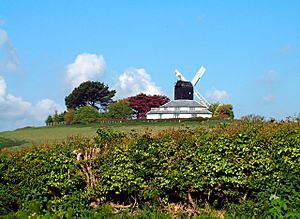Hogg Hill Mill, Icklesham facts for kids
Quick facts for kids Hogg Hill Mill, Icklesham |
|
|---|---|

The mill in 2005
|
|
| Origin | |
| Grid reference | TQ 888 160 |
| Coordinates | 50°54′47″N 0°41′02″E / 50.913°N 0.684°E |
| Year built | 1781 |
| Information | |
| Purpose | Corn mill |
| Type | Post mill |
| Roundhouse storeys | Two storey roundhouse |
| No. of sails | Four |
| Type of sails | Spring sails |
| Windshaft | Cast iron |
| Winding | Roof mounted fantail |
| Fantail blades | Eight blades |
| No. of pairs of millstones | Two pairs, arranged Head and Tail |
| Other information | The only existing post mill in the United Kingdom retaining a roof mounted fantail. |
Hogg Hill Mill is a special old post mill located in Icklesham, a village in East Sussex, England. It's famous for being one of the last windmills of its kind in the United Kingdom that still has a unique roof-mounted fan. Today, this historic mill has a surprising new life as a recording studio!
The Mill's Amazing Journey
Hogg Hill Mill was first built way back in 1781 in a place called Pett. Just nine years later, in 1790, it was carefully moved to its current spot in Icklesham. For many years, the mill used the power of the wind to grind corn. It kept working until 1920, when it had to stop because a main wooden beam became too weak.
Today, Hogg Hill Mill is no longer grinding corn. Instead, it's a super cool recording studio owned by Sir Paul McCartney, a famous musician from The Beatles!
How This Windmill Works
Hogg Hill Mill is a type of windmill called a post mill. This means the entire top part of the mill, which holds the machinery, can turn around on a central post. This allows the mill to face the wind from any direction. It sits on a two-story building called a roundhouse.
The mill has four large sails that catch the wind. These are special "spring sails" that can adjust to different wind speeds. A strong metal shaft, made of cast iron, holds the sails. The mill also has a unique roof-mounted fantail. This small fan at the back automatically turns the mill's main body so the big sails always face the wind. It's one of only two such fantails left on post mills in England!
Inside, the mill used to drive two pairs of millstones. These large stones would grind the corn into flour.

